 The grueling war between Screen Cartoonists Local 1461 and Terrytoons dragged on into the spring of 1947. Paul Terry wriggled and dodged every attempt to bring him to the bargaining table, making numerous promises he never intended to keep. John Gentilella, current President of the local, had experienced Terry’s wrath personally as part of a mass firing. Johnny Gent immediately got scooped up by Famous Studios, where Sam Buchwald’s anti-union machinations were subtler, but no less spiteful.
The grueling war between Screen Cartoonists Local 1461 and Terrytoons dragged on into the spring of 1947. Paul Terry wriggled and dodged every attempt to bring him to the bargaining table, making numerous promises he never intended to keep. John Gentilella, current President of the local, had experienced Terry’s wrath personally as part of a mass firing. Johnny Gent immediately got scooped up by Famous Studios, where Sam Buchwald’s anti-union machinations were subtler, but no less spiteful.
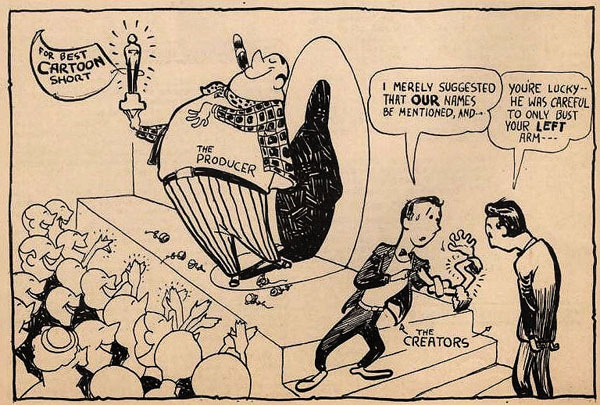
Perry Rosove held the position of both vice president and Top Cel editor. Rosove’s faction wanted to politicize both the local and the newsletter, so SCG 1461 dealt with both internal and external struggles as union elections rolled around in June of 1947. Gordon Whittier, a Famous Studios animator also fired from Terrytoons for union activities, became president of the local, with Johnny Gent as v.p. Perry Rosove retained editorship of Top Cel.

The newsletter, printed as a fold-over four pages, still used the masthead designed by Pete Caldera a couple years earlier. It maintained a slick look, interspersed with cartoons and clip art. Perry Rosove had recently been in the middle of it when Minitoons, where he worked, challenged the union and locked the employees out.
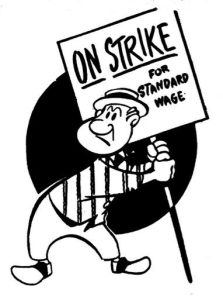 Minitoons, located at 1697 Broadway, was formed by three former Disney animators: Wilbur Streetch, Joe Magro, and Bob Leffingwell. Coca Cola was their first big client and those commercials were aimed at the European market. They would air in Britain first, and be dubbed for France, Holland, Italy, and Belgium. Minitoons did animation on A HEADQUARTERS FOR THE UNITED NATIONS. Top talent passed through the place: animators Phil Klein, Carmen Eletto, and Earl Murphy – inkers Jean Selby, Sylvia Alevy, and Louise LeFleur. Local 1461 brought Minitoons back into line.
Minitoons, located at 1697 Broadway, was formed by three former Disney animators: Wilbur Streetch, Joe Magro, and Bob Leffingwell. Coca Cola was their first big client and those commercials were aimed at the European market. They would air in Britain first, and be dubbed for France, Holland, Italy, and Belgium. Minitoons did animation on A HEADQUARTERS FOR THE UNITED NATIONS. Top talent passed through the place: animators Phil Klein, Carmen Eletto, and Earl Murphy – inkers Jean Selby, Sylvia Alevy, and Louise LeFleur. Local 1461 brought Minitoons back into line.
So, Perry Rosove’s hard-line approach was not unfounded. Prussian born Bill Henning, another animator at Famous, denounced Rosove’s editorial policy as un-American. The June 1948 elections put Jack Zander in the presidency, but Perry Rosove won a third term as Top Cel editor. The format changed to a single, legal sized sheet printed on both sides. The masthead design was drastically simplified. No more cartoons or clip art.

As the Terrytoons strike wound down, the union felt Cineffects slipping away, but Pepe Ruiz’s relentless efforts shepherded them back into fold. The number of animators opening shops in the Big Apple took an upswing. Ben Harrison returned from Hollywood to his New York roots and opened a studio. Joe Oriolo had left Famous to start Animated Teletoons. The union was in negotiations with them both, as well as with Tempo Productions.
The rise of television did much to cause this proliferation of smaller studios. 49 advertisers paid to sponsor TV shows the year before. In 1948 that number was up to 380 sponsors. Television stations were assembling their own little animation departments. With CBS already in compliance, Local 1461 initiated talks with WPIX and the ABC network.
 Union meetings were held at the Capitol Hotel on Eighth Avenue and 51st Street until May of 1949 when they moved to the Hotel Claridge ballroom. Broadway and West 44th Street sat at the heart of the Times Square district. Many Screen Cartoonist Guild members worked within a couple blocks of the Claridge. Douglas Leigh’s iconic smoking billboard adorned the building, a fitting symbol for a trade turning its focus from pure entertainment to unapologetic commercialism.
Union meetings were held at the Capitol Hotel on Eighth Avenue and 51st Street until May of 1949 when they moved to the Hotel Claridge ballroom. Broadway and West 44th Street sat at the heart of the Times Square district. Many Screen Cartoonist Guild members worked within a couple blocks of the Claridge. Douglas Leigh’s iconic smoking billboard adorned the building, a fitting symbol for a trade turning its focus from pure entertainment to unapologetic commercialism.
Jack Zander won a second term as president in the June 1949 elections. The board had some new faces. Perry Rosove didn’t run for Top Cel editor and Larry Riley beat Tex Henson for the post. Animation House in New Rochelle joined the union. Ed Rehberg established Animation House right near Terrytoons in response to what he considered shabby treatment by Paul Terry. Union membership grew when Lars Calonius departed Disney to start Archer Productions in New York. Spectrolux Television Corporation at 48 East 43rd Street used a process of trick lighting they called “mat service” to create cheap semi-animation that could be delivered in two days. Despite the gimmick, Spectrolux signed with the union so it could hire capable talent such as Ben Farish, Jimmy Tanaka, Gordon Sheehan, and Fred Diamond.
Al Stahl Productions, moving into 1600 Broadway, signed up. Stahl had a reputation as a nice guy who paid his inkers cash for overtime. Transfilm, with an expanding animation department, signed as well. Minitoons had closed. Some small operators like Bray Studios, Ted Eshbaugh, Albert Paganelli, Edna Gamble, Hugo Chain, Ben Greene, and Evan J. Anton ignored the union. The amount of animation work being done in New York was astounding.
As 1950 dawned Shamus Culhane was back in town. He’d been an early advocate of a union, but couldn’t even belong now because he was management at Shamus Culhane Productions. Bill Sturm left Fletcher Smith to open his own studio. The addition of these two brought the number of Local 1461’s contract studios to sixteen. Terrytoons was again outside their reach.
Larry Riley’s year as Top Cel editor had been uneventful. He stayed on budget. No format changes took place. Riley struggled with alcoholism, and did not run again. The new editorship came in with a fresh approach and a new masthead.

Al Semels from Film Graphics took the reins, only to be ambushed by president John Gentilella and the new board during a meeting at Pepe Ruiz’s apartment.

Returning to a four-page format, Top Cel once again included illustrations, but of a much artsier nature.

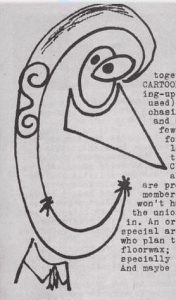 An Organizing Committee was convened to aggressively court contracts with Terrytoons, Loucks & Norling, Audio Productions and McGraw-Hill. There was agreement to cooperate with Chicago Local 852 in securing contracts with Wilding Pictures, as well as Detroit-based Jam Handy, both of which had New York branches.
An Organizing Committee was convened to aggressively court contracts with Terrytoons, Loucks & Norling, Audio Productions and McGraw-Hill. There was agreement to cooperate with Chicago Local 852 in securing contracts with Wilding Pictures, as well as Detroit-based Jam Handy, both of which had New York branches.
Screen Cartoonists Guild Local 1461 had always been affiliated with the Brotherhood of Painters, giving them autonomy, but little support. A showdown with Famous Studios seemed inevitable in early 1951. As the union prepared for a strike, it broke away from the Brotherhood of Painters. The strike was averted, but New York’s SCG chapter found itself alone. Publication of Top Cel ceased through most of 1951, appearing again in December with the following greeting:

They were no longer Local 1461. Now they were just an unaffiliated chapter of the Screen Cartoonists Guild, fending for themselves. The June elections kept Johnny Gent as president and chose Peggy Ebeling as Top Cel editor. Her husband Bob Ebeling animated at Shamus Culhane Productions. Aside from that I find no other mention of her. There’s a drawing in one of the issues.
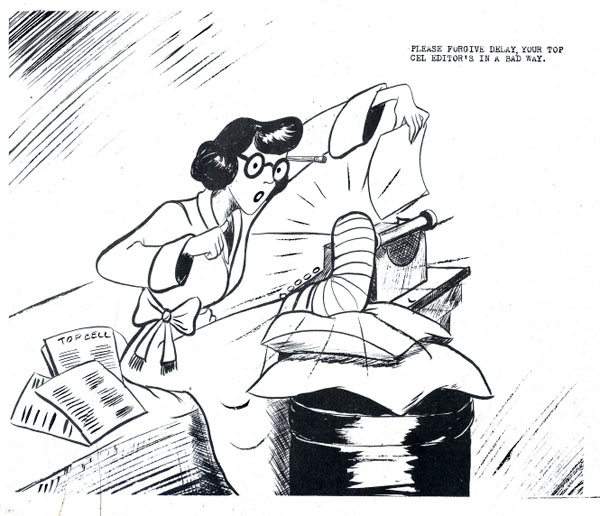
Peggy Ebeling assumed control of the newsletter at a critical juncture for the Screen Cartoonists Guild. Their west coast chapter had just affiliated with the International Alliance of Theater and Stage Employees. New York was largely on its own. Pressure against unions in general increased due to the McCarthy Hearings. Top Cel reported closely on such activities. Artwork was tastefully included, and the FLIPPINGS column kept the publication personal.
A number of studios belonging to the local were involved in founding the Film Producer’s Association for the purpose of promoting New York as “a source of the best non-theatrical films for television and commercial motion pictures”. To that end this FPA enlisted aid from the New York City Department of Commerce and the state and city chambers of commerce. Members included: Audio Productions; Pathescope Company of America; Willard Pictures; Video Varieties; Transfilm; Leslie Roush Productions; John Bransby; Caravel Films; Sound Masters; Films for Industry; Paul Hance Productions; Murphy-Lillis; Herbert Kerkow; Affiliated Film Producers; William J. Ganz; and Film Graphics. Of those sixteen companies at least fourteen offered animation services. This group comprised about three-quarters of NYC’s general service studios.
Let’s play the numbers game. Over thirty percent of U.S. households had television sets, nearly three million of them in the New York area. Negotiations were underway between the SCG and the NBC network. The union sought help from the International Alliance of Theater and Stage Employees in dealing with an ABC sponsor. The Screen Cartoonists resolved to affiliate with the IATSE as Motion Picture Screen Cartoonists Local 841. Elections were postponed until November while details such as writing new by=laws were attended to.

November meant Federal elections as well. Much hung in the balance as America decided which post-war path it would take. The Republicans had Disney animate a campaign ad for their candidate Dwight Eisenhower. For the most part, unions supported Democrats. Top Cel reminded its readers to do their part.
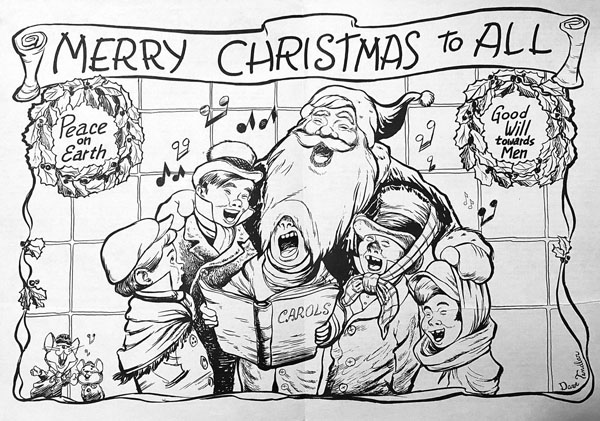
With so much transition already swirling about, Local 841 opted to keep their present executive board in place until regular June elections. There’d been a walkout at Transfilm that demanded their attention. Wrangling with the Wage Stabilization Board concerning thirty-five hour work weeks was ongoing. The station WOR-TV was in negotiations. The local and its newsletter moved along smoothly. Dave Tendlar contributed a festive holiday centerfold.
Terrytoons remained defiant as 1953 got underway, and Famous Studios stalled new contract negotiations. As the east coast’s two remaining manufacturer of theatrical cartoons, these companies held great sway in New York’s animation industry, but that influence was waning. Anti-trust lawsuits altered the way exhibitors showed movies. Short subject films were no longer as profitable. Television evolved into animation’s new marketplace. Animated commercials resonated with the public. A boost to that situation had to do with the new Screen Actors Guild contract concerning residuals. Actors only got them if they actually appeared on camera. In the long-run it was cheaper to draw the actors, because animators never got residuals.
Motion Picture Screen Cartoonists Local 841 held their 1953 elections in July. Film Graphics animator Lucifer Guarnier took over the presidency. Peggy Ebeling continued as Top Cel editor. Contracts were signed with UPA, Cineffects, and Eastern Effects. Negotiations opened with Caravel Pictures. Paul Terry continued to thumb his nose.
In November of 1953 Top Cel posted this notice:

The trouble with committee situations is that everybody wants a say, but few want to shoulder responsibility. Neil Sessa did much of the legwork to keep Top Cel going. Sessa’s job title or studio is unknown. He’d started out at Fleischer Studios in 1935. The Army Signal Corps stationed him in India during the war. Neil’s wife Margaret Sessa had been at the Signal Corps’ Astoria unit from 1943 to 1950, and currently worked for Transfilm. Neil had been among the workers locked out by Minitoons.
The new Top Cel went overboard with clip art.

Besides continuing this community bulletin board, Top Cel added a classified ads column, and one to keep track of members in the military. All combined with a healthy dose of union info. The Top Cel committee monetized the newsletter.

Art supply store Crane-Gallo was the first to advertise. Another advertiser appealed to the many Jazz fanatics in the animation crowd, Ed Smith among them. Smith graduated Columbia University with an art degree, part of the hot young talent working at Film Graphics beside Vince Cafarelli, Fred Mogub, Howard Beckerman. The most ardent Jazz fan was Ed Smith, who owned hundreds of records. Smith contributed a cartoon to the April 1954 Top Cel. Film Graphics employees were big supporters of the union. Animator Lucifer Guarnier borrowed a projector from that studio to run films after monthly meetings so attendees could view each-other’s recent work.
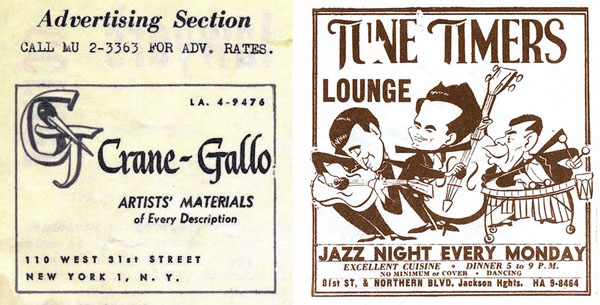
The Film Producer’s Association lobbied to exclude family members from the welfare plan. Local 841 prepared to go on strike, but the issue was resolved favorably. Local 841’s business agent Pepe Ruiz may not have been widely loved, but he was effective. Local 841 signed four new contracts that April: Tempo Productions sold to new management as Academy Productions; comic book artist Chad Grothkopf incorporated as Chad Associates; Jack Zander quit Transfilm and started Pelican Films; a Hollywood studio branched into NYC as John Sutherland Television Productions. Ed Smith went over to Sutherland.
In May of 1954 Neil and Margaret Sessa opened the Film-Art Animation Service, keeping him too busy to edit Top Cel. Ed Smith took over the newsletter responsibilities. Terrytoons finally knuckled under, just as Local 841 moved out of Pepe Ruiz’s Riverside Drive apartment into an actual office space at 15 West 44th Street. Pepe Ruiz could often be found two blocks away, conducting business from the Rustic Bar, across from the Claridge Hotel. The Mexican restaurant Xochitl on 46th Street, with its amiable hosts Paz and Juvencio Maldonado, saw steady traffic from New York’s animation bunch. Persian restaurant the Teheran at 45 West 44th Street had a bar and free hors d’oeuvres between 5 and 8 P.M. After meetings Local 841 gathered upstairs there. Kilroy’s, on Sixth Ave between 42nd and 43rd Streets, was a favored haunt of copywriters and art directors, who worked out the details of many TV commercials at the bar.
Lucifer Guarnier won the president’s seat in June of 1954. The experiment of editing the newsletter by committee flopped. All the advertisers had pulled out except one. Crane-Gallo would place their ad for another five years. Ed Smith was elected Top Cel editor, and would be re-elected for the next thirteen. The newsletter found its rhythm.


 BOB COAR made his way in this world as a muralist and sign painter, illustrating on just about every surface imaginable. A life-long fan of animation, he is currently searching for digital, or actual, copies of Top Cel.
BOB COAR made his way in this world as a muralist and sign painter, illustrating on just about every surface imaginable. A life-long fan of animation, he is currently searching for digital, or actual, copies of Top Cel. 









































Two questions:
1. What sort of false promises did Paul Terry make during the lead-up to the Terrytoons strike in 1947?
2. What were Sam Buchwald’s “anti-union machinations” at Famous? It was my understanding that when the studio moved back to New York in 1943, the old in-house company union merged with the SCG, and Famous signed a contract with them.
The Terrytoons strike was a terrible ordeal for those who took part in it. Westchester County was a conservative place in those days, and the people on the picket lines were subject to many stringent legal restrictions. They weren’t even allowed to speak; they could be arrested and sent to jail just for saying a single word. Each day passersby would call them Communists and otherwise abuse them, and they couldn’t say anything in reply. They endured this for months, yet lost in the end. According to Jim Logan, one of the strikers who went on to work for a number of New York studios that made animated TV commercials, “A few years later Terrytoons called the union asking if they could sign a contract with the Screen Cartoonists’ Guild. Terrytoons was stuck with strike breakers not worth Terrytoons’ low pay, and needed real talent.”
Complex answers, Terry agreed to meetings and never showedm fir one thond. Buchwald moved ubion supporters into unfamiliar jobs, then fired them for incompetence.
FYI – I typed that last response in the dark.
Are any Minitoons’ projects available to watch online? I’m curious about the United Nations film.
I’m guessing Paul Terry’s long-delayed assent to the union coincided with CBS offering to buy his studio, which deal was sealed in 1955. He unionized because it would be someone else’s problem soon.
My great uncle Paul was ready to retire and knew a union shop would probably get more money.
Thank you for sharing these Peg-Boards.
Perhaps someone can help me. My father, Jack Dazzo, was a TV commercial and cartoon animator. He was a member of IATSE and my mom now receives his pension from them as he is deceased. I found a Group life insurance policy issued by Union Labor Life Insurance Company to Motion Picture Screen Cartoonists Local 841. I see from the above article that this local became affiliated with IATSE at some point.
I cannot track down any information on this policy which contains 2 policy numbers on the document. I have called IATSE National Benefits Fund and Union Labor Life insurance and a few other numbers i was referred to, but no one knows anything about this policy.
are any top cel issues available for sale or consult? Cheers
I have 11 issues from 1973 for sale on eBay. Missing May. All are in excellent condition.
https://www.ebay.com/itm/335496175750
https://www.ebay.com/itm/335542373493
10 issues of Top Cel from 1972 with cover art by Izzy Klein.
Thank you.